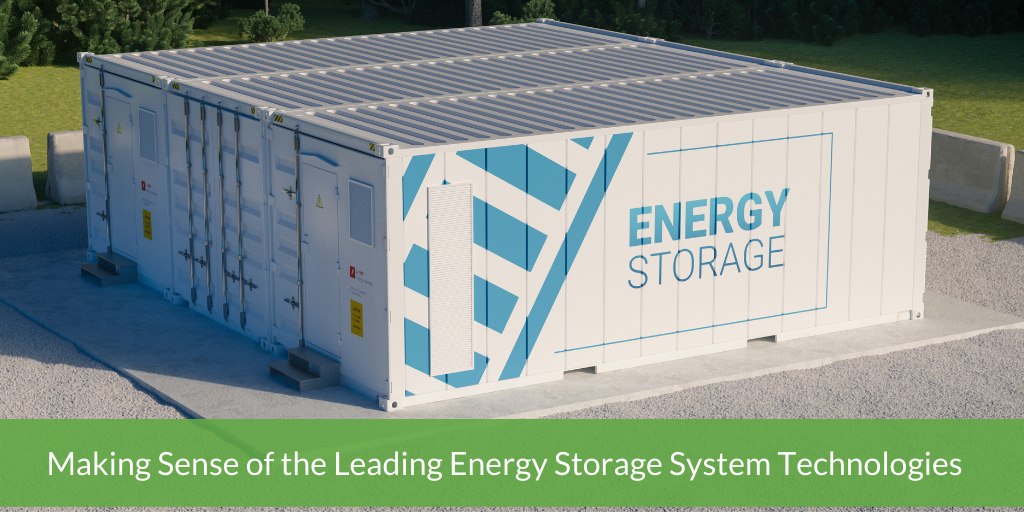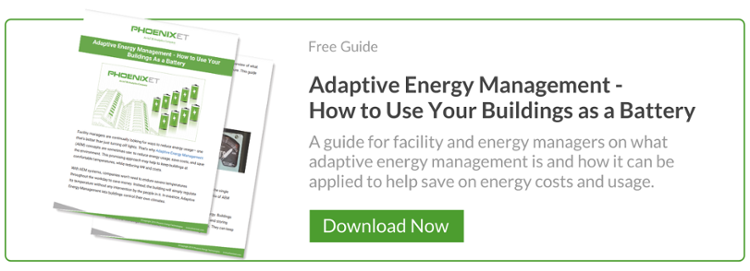Share this
Making Sense of the Leading Energy Storage System Technologies
by Phoenix Energy Technologies on Sep 7, 2021

Backup power is essential for reducing downtime and ensuring continuous operations of your buildings and equipment. Understanding the differences between commercially available power storage options can help you save your organization time, energy, and money. In this post, we look at the top uninterrupted power sources (UPS) battery backup systems on the market and outline their capabilities and costs.
Why is Battery Backup Important?
According to a 2021 report, the average cost of just a single hour of downtime has risen to $84,650. However, the true cost can be much higher when factoring in other influences, which include:
- Loss of customer and employee confidence
- Damage to brand integrity
- Diversion of resources from long-term business-critical projects
- Reduced stock prices
- The threat of legal action
- Revocation of licenses or accreditations
The market for uninterrupted power supplies is growing rapidly due to the wealth of organizations whose success depends on the ability to keep systems, networks, and platforms running at all times without unexpected downtime.
Top UPS Energy Storage Systems
There are four leading types of uninterrupted power sources, or UPS, that give your buildings the ability to maintain operations in the event of a critical power failure. They each provide different technical capabilities and advantages depending on the building control systems you are already using and what your current UPS situation looks like.
The four leading UPS technologies are:
- Lead-Acid Batteries
- Lithium-Ion Batteries
- Nickel-Zinc Batteries
- Flywheels/Rotary Systems/Crankshafts
Energy Terms
To better understand the unique benefits and challenges of deploying one solution over another, you need to be familiar with the following terms:
- Cycle Life: The measurement of the number of times a battery can be reduced in power to 50% or less and then adequately charged back to 100% capacity.
- Discharge Rate: This measurement of time it takes for an energy storage system to completely discharge or deplete all of its energy reserves.
- Thermal Runaway: This describes what happens when an energy storage system cannot safely and adequately discharge its generated heat. (Excessive thermal runaway can lead to hazardous explosions.)
- Battery Management System: A platform or system used by facilities managers to evaluate the performance of energy storage systems in real-time.
Comparing UPS Technologies
Lead-Acid Batteries
Lead-acid batteries remain the most tried and trusted energy storage system deployed to provide backup power. For facilities already using lead-acid batteries, there is likely little incentive to switch over to a new system that would require firmware or platform updates to work correctly.
Lead-Acid Battery Capabilities
Lead-acid batteries are likely to support between 300 and 600 discharges and typically have a warranty of 3-5 years. However, it is not uncommon for facilities managers to replace them several times over the 10-year life span of their UPS system.
Lead-acid batteries support high power discharges and are suited for high-current applications. The best lead-acid batteries for UPS systems can handle a 7.5 (8C) to 10 minutes (6C) discharge rate. They can recharge in as little as two or as many as 24 hours, depending on various factors.
Lead is a very dense and heavy metal. As a result, lead-acid batteries take up a great deal of space and require extensive cooling support to run correctly. Temperatures above 76 F (25 C) are likely to degrade or damage lead-acid batteries.
Furthermore, lead-acid batteries require quarterly maintenance every 3 months to continue running optimally compared to other leading energy storage devices. Though their initial cost is much lower than other energy storage systems, the cost of constantly replacing and maintaining lead-acid batteries will add up over the years.
Lithium-Ion
Lithium-ion (Li-ion) batteries are a much newer innovation in the area of UPS technology. One of the main advantages of this energy storage system is that Lithium iron phosphate batteries deliver a cycle life of 1,000 to 3,000 discharges and can last for 10-15 years.
Lithium-Ion Battery Capabilities
Lithium iron phosphate batteries typically can supply 2-minute (30C) discharge rates, which is a major advantage for UPS applications. Additionally, these batteries are likely to be completely recharged in around 2 hours after depletion.
Lithium-ion batteries weigh 60-80% less than lead and only require about 50% of the floor space. They can also safely and efficiently operate at 86 F (30 C), which helps to reduce additional cooling costs.
Li-ion energy storage systems do not need to be tested quarterly like lead batteries but require a yearly inspection. These batteries are likely to cost 1.2 to 1.5 times as much as their lead-acid competitors.
Additionally, because lithium iron phosphate has a thermal runaway temperature of 518 F (270 C), a pierced battery could result in a severe explosion or fire.
Nickel-Zinc Batteries
Nickel-Zinc batteries are quickly emerging as one of the more innovative energy storage systems available for UPS applications. High-quality nickel-zinc batteries deliver an average cycle life between 600 cycles at 100 percent depth of discharge and up to 150,000 cycles at 1 percent depth of discharge.
Nickel-Zinc Battery Capabilities
These batteries support a maximum discharge rate of 6 minutes (12C) and can be charged from 0 to 93% or higher in less than an hour, though many can take up to 4 hours to reach a complete 100% recharge.
Nickel-zinc batteries are about half the size of comparable lead batteries. They are likely to take up a much smaller footprint. One of the main advantages of nickel-zinc batteries is their ability to operate at even extremely high temperatures without being damaged or degraded, which leads to significant cost savings over the life cycle of your facility.
Compared to leading lead battery solutions, nickel-zinc does not require quarterly testing, though a yearly inspection is recommended.
Although the initial cost of nickel-zinc batteries is higher than lead batteries, their lifetime value is typically higher. Additionally, these batteries pose no fire risk and do not have any thermal runaway potential.
Flywheel Batteries
A flywheel system uses the power of kinetic energy or movement to generate and disperse power. As a result, flywheels do not have a cycle life. Their storage capacity does not diminish at all with repeated use over many years.
Flywheel Battery Capabilities
Flywheels can typically discharge their power in 15 to 20 seconds and can recharge in just 2 minutes. Magnetic flywheels are the most powerful and efficient when discharging the highest amount of energy as quickly as possible.
Flywheels are relatively small in size relative to their power output. Their size footprint is closest to lithium-ion batteries, and they are considerably lighter than lead-acid energy storage systems. Additionally, flywheel systems do not have the same intensive cooling needs as many batteries.
Traditional flywheel systems run using mechanical ball bearings typically require regular maintenance. Newer models using magnetic power do not require the same amount of maintenance or replacement parts.
Flywheels and lead-acid batteries are likely to have similar initial costs. However, due to savings from reduced cooling and maintenance needs, flywheels could be less expensive over their complete life cycle.
Bringing Down Energy Costs
If you are looking to bring down energy costs and usage across your facilities, we encourage you to check out our guide Adaptive Energy Management - How to Use Your Buildings as a Battery.
Adaptive energy management uses building monitoring systems, automation, and A.I. to help you reduce usage and save on energy spend across your portfolio. The guide outlines how you can:
- Even out energy demand curves
- Cut down on energy demand during peak hours to reduce peak charges
- Keep occupants cool even on hot days
- And much more!
Download the free guide to learn more!
Additional Resources:
Top 3 Benefits of Benchmarking for Facilities Management
Energy Efficiency AND Customer Comfort CAN Coexist
Smart Buildings, Building Automation - What's the Point?
Share this
- Facilities Management (91)
- Energy Management (69)
- Company News (49)
- Smart Buildings (37)
- Retail (36)
- Building Management (24)
- Building Automation Systems (21)
- Sustainability (20)
- Energy Demand Management (19)
- EEI (15)
- Adaptive Energy Management (14)
- Grocery (14)
- demand response (14)
- Artificial Intelligence (12)
- Data Integration and Visibility (10)
- HVAC IQ (9)
- COVID-19 (8)
- Customer Spotlight (8)
- Carbon Management (7)
- Setpoints and Temperatures (7)
- Equipment Maintenance (6)
- Operational Efficiency (6)
- Refrigeration Optimization (6)
- Ask Ron (5)
- Asset Manager (5)
- Finance and Procurement (5)
- IoT and Digital Transformation (5)
- Awards (4)
- Comfort (4)
- Energy & Store Development (4)
- Safety and Compliance (4)
- Demand Charge Management (3)
- Energy Management System (3)
- Lifecycle Asset Management (3)
- Premium Services (3)
- Refrigeration IQ (3)
- Automated Demand Response (2)
- ConnexFM (2)
- Customer Service (2)
- HVAC Vendor Management (2)
- Load Shedding (2)
- Technician View (2)
- AIM Act (1)
- ALD (1)
- Analytics (1)
- Data (1)
- Data Integration and Visualization (1)
- EMS (1)
- Knowledge Center (1)
- OSHA (1)
- asset management (1)
- December 2025 (1)
- November 2025 (1)
- October 2025 (2)
- September 2025 (1)
- August 2025 (3)
- July 2025 (1)
- June 2025 (1)
- May 2025 (2)
- March 2025 (2)
- February 2025 (1)
- January 2025 (2)
- December 2024 (2)
- October 2024 (1)
- September 2024 (1)
- August 2024 (2)
- June 2024 (2)
- April 2024 (2)
- March 2024 (2)
- January 2024 (1)
- December 2023 (1)
- October 2023 (2)
- September 2023 (2)
- August 2023 (2)
- July 2023 (1)
- May 2023 (2)
- April 2023 (2)
- March 2023 (3)
- February 2023 (1)
- January 2023 (1)
- December 2022 (1)
- November 2022 (2)
- October 2022 (2)
- September 2022 (1)
- May 2022 (2)
- April 2022 (1)
- March 2022 (3)
- February 2022 (2)
- January 2022 (4)
- December 2021 (2)
- November 2021 (3)
- October 2021 (1)
- September 2021 (3)
- August 2021 (4)
- July 2021 (1)
- June 2021 (2)
- May 2021 (1)
- January 2021 (2)
- December 2020 (2)
- November 2020 (2)
- October 2020 (3)
- September 2020 (4)
- August 2020 (3)
- July 2020 (2)
- June 2020 (3)
- May 2020 (3)
- April 2020 (5)
- March 2020 (5)
- February 2020 (4)
- January 2020 (4)
- December 2019 (4)
- November 2019 (3)
- October 2019 (4)
- September 2019 (5)
- August 2019 (4)
- July 2019 (4)
- May 2019 (2)
- April 2019 (3)
- February 2019 (1)
- December 2018 (1)
- November 2018 (1)
- October 2018 (3)
- September 2018 (3)
- August 2018 (3)
- July 2018 (3)
- June 2018 (3)
- May 2018 (1)
- June 2015 (1)
- March 2013 (1)
- January 2013 (1)
- December 2011 (1)
- October 2011 (1)
- September 2011 (1)


